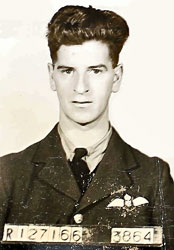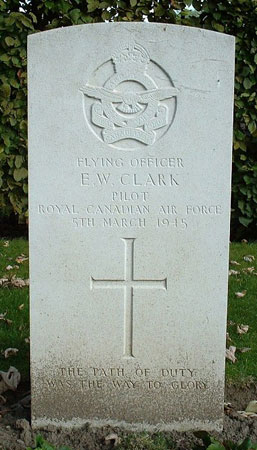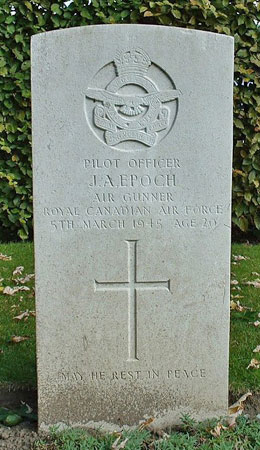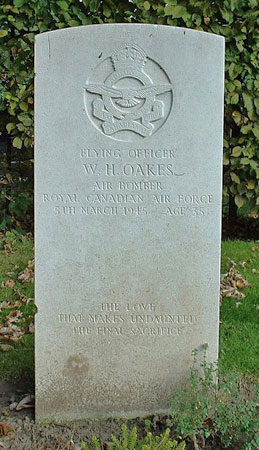On evening of the 5th March 1945 the crew of this 420 Squadron aircraft took off from Tholthorpe airfield at 16.28hrs to undertake an operational flight to bomb Chemnitz. On this night extreme unforecast weather conditions over the Vale of York saw a large number of the bombing force that took off at around the same time ice up and some of them simply fell out of the sky having got into flat spins. I have yet to find any proper details for the exact events of what happened with Halifax NA184 but it probably iced up while flying in cloud before setting out on the operational sortie. In general teems squadron aircraft would get into the air one by one and fly around the general area of the airfield climbing to a few thousand feet awaiting all their squadron aircraft gaining the same height and setting out on the operations together. The pilot of this aircraft had probably realised that he had lost control and ordered the crew to bale out, unfortunately only three of them were able to make their escape and while they survived their landings two sustained serious injuries, probably having baled out at around the lowest limit for their parachutes to work. At 16.50hrs this aircraft crashed near Marrow Flatts Farm, Copt Hewick, on the Ripon side of Dishforth airfield. The remaining four crew were either killed in the crash or had baled out at too low a height for their parachutes to open.
Pilot - F/O Earl William Clark RCAF (J/89818), aged 27, of Montreal, Quebec, Canada. Buried Harrogate Stonefall Cemetery, Yorkshire (H/P/19).
Flight Engineer - Sgt James Burton Kirby RAFVR (1606854), aged 20, of Windsor. Buried Windsor Cemetery, Berkshire.
Bomb Aimer - F/O William Hugh Oakes RCAF (J/40103), aged 25, of Swan Lake, Manitoba, Canada. Buried Harrogate Stonefall Cemetery, Yorkshire (H/P/20).
Air Gunner - P/O Jerome Aquinius Epoch RCAF (J/94406), aged 20, of Kenilworth, Ontario, Canada. Buried Harrogate Stonefall Cemetery, Yorkshire (H/P/18).
Navigator - F/O B V Freed RCAF (J/40803). Slightly injured.
Wireless Operator / Air Gunner - F/Sgt Robert John Arnold RCAF (R/252886). Seriously injured.
Air Gunner - P/O Harold Morris O'Connor RCAF (J/93634). Seriously injured.


Earl Clark was born on 29th July 1917 at Montreal, Quebec, Canada and was the son of Richard and Clara Beatrice (nee Allsopp) Clark. He was working as a clerk for Noordvyn Aviation in Montreal when he enlisted for RCAF service on 15th August 1941 also in Montreal for ground duties and initially served as an aero engine mechanic. He married Eunice Cunningham in June 1942 in Montreal. He appears to have remustered as aircrew in Summer 1943 and underwent pilot training, receiving his pilots' flying badge on 12th November 1943. He arrived in the UK in April 1944 he received a commision on 15th August 1944 and would train at 11 (P)AFU, 86 OTU and 1666 HCU before posting to 420 Squadron on 24th December 1944. His brother George served in the RCAF during WW2.


Jerome Epoch was born on 30th December 1924 at Kenilworth, Ontario, Canada and was the son of George Alphonsus and Teresa Jane (nee Tangney) Epoch. After leaving high school he worked as a lathe operator for a local company before enlisting for RCAF service on 7th September 1943. Having trained as an air gunner he was awarded his air gunners' flying badge on 7th April 1944. On arrival in the UK he trained at 86 OTU and 1666 HCU before posting to 420 Squadron on 24th December 1944. He appears to have received a commission after his death, back dated to 4th March 1945. His brother John served in the RCAF during WW2.

William Oakes was born on 11th September 1909 at Miami, Manitoba, Canada and was the son of William and Helen (nee Cuthbertson) Oakes. Both his parents were born in Scotland and had married at Strathaven in 1905 before emigrating. William (Jnr) had been working as a grain elevator operator from 1932 until enlisting for RCAF service on 11th August 1941 for ground duties. He initially served as a RCAF motor mechanic but in November 1941 switched to being an RCAF transport driver. He then remustered as aircrew towards the end of 1942 and appears to have initially undertaken pilot training but later switched to being an air bomber, he was then awarded his air bombers' flying badge and also a commission on 23rd December 1943. His postings in the UK are not yet known but he probably trained at 86 OTU and 1666 HCU before posting to 420 Squadron in December 1944.
Harold O'Connor was born in Pleasantdale, Saskatchewan, Canada in 1922 and enlisted for RCAF service in April 1941. During his RCAF service he served with 424 Squadron, 415 Squadron, and 420 Squadron. He later returned to Canada and served with the Chatham Fire Department in Ontario for forty years. He died in January 2004.
Robert Arnold was born in Turtleford, Saskatchewan, Canada. He had initially enlisted into the Canadian Army in 1941, serving with the Royal Canadian Engineers before transferring to the RCAF in 1943. In the UK he fle with 420 Squadron and 424 Squadron. He died in December 2016 aged 96.
William Chorley's superb Bomber Command series of losses books lists the navigator as being "F/O D.V.Freed" instead of B.V.Freed. B.V.Freed is given in the squadron records and also on the accident records and is almost certainly correct. I find it remarkable just how many websites have copied across this error without any indication of a credit for Mr Chorley and the years of research he has put into the books. Had they bothered to take a look at some contemporary records they would have realised the error. Bill Chorley's mammoth task of documenting all Bomber Command losses deserves far more credit than he has ever been given.

Air historians Albert Pritchard, Eric Barton and Ken Reast located small fragments on the surface at the crash site in February 1999 with permission from the landowner, confirming the crash location. The item shown above was picked up at the crash site and retained by Eric. While I have never agreed with pocketing bits found at crash sites, his son passed his small collection of items to me to find a new home for in 2022 which has allowed me to photograph the items and update some webpages with the more interesting items.